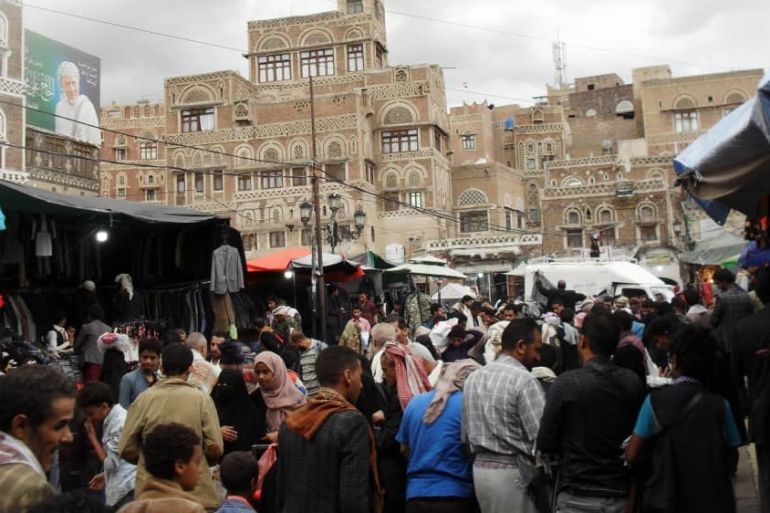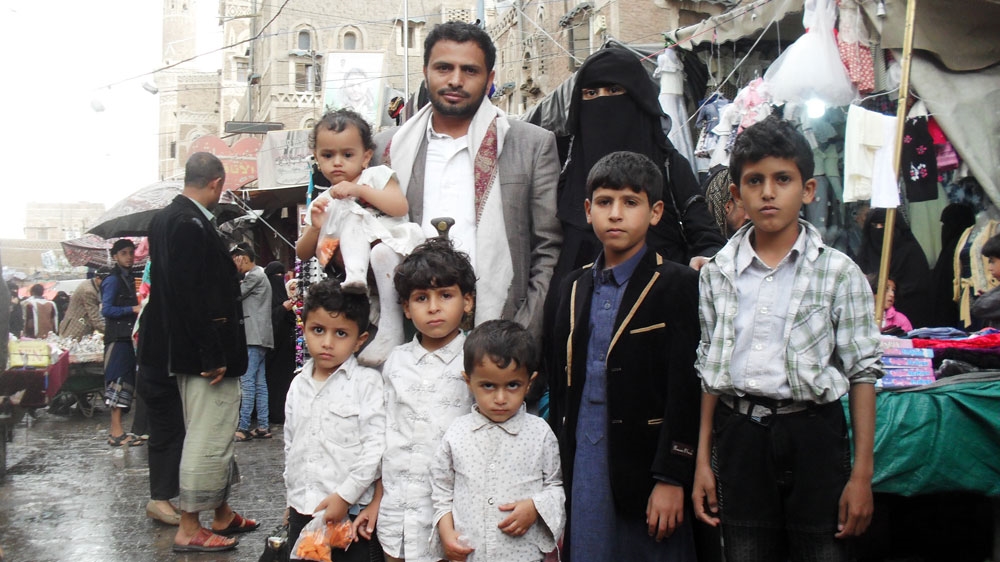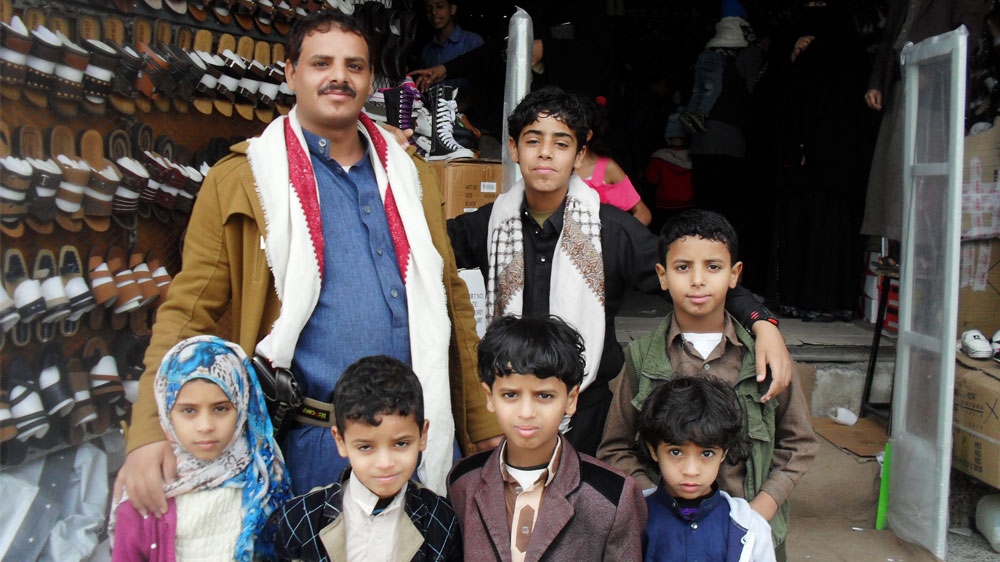As Yemenis prepare for Eid, even celebration is a struggle
This year, families celebrate being alive and healthy as poverty, unemployment dampen spirits in war-torn Yemen.

Sanaa, Yemen – Fawaz Fara rummaged through piles of clothes at a market in Sanaa as his wife Asma’a and six children watched. He stopped and told the vendor he could not afford anything, then led his family away.
“One [of my girls] asked me to buy toys for her. Another cried and asked why I don’t buy anything,” said Fara, 35. “I told them I couldn’t even afford clothes. How can I afford toys?”
Keep reading
list of 4 items‘Triple spending’: Zimbabweans bear cost of changing to new ZiG currency
‘We share with rats’: Neglect, empty promises for S African hostel-dwellers
Thirty years waiting for a house: South Africa’s ‘backyard’ dwellers
This is the first year he can not buy new outfits for each to wear on Eid al-Fitr, marking the end of the holy month of Ramadan.
Fara had earned a good living as a security guard at a park in central Saudi Arabia for the past nine years.
He was sending enough money back to Asma’a in Yemen to support the whole family, and she could afford to splurge on expensive clothes for the children to wear on Eid.
They had enjoyed a high standard of living in a country where the average person lived on $4.50 per day before the war started in 2015. That amount plummeted to $1.80 per day a year later.
Since March 2015, a Saudi-UAE-led coalition, supporting the Yemeni government, has been at war with the Houthi rebels.
The four-year-conflict has killed tens of thousands of people and pushed the Arab world’s poorest country to the brink of famine.
People with financial means used to sing joyously during Eid as they ate sweets, decked out in fancy new clothes.
This year, they are celebrating being alive and healthy, joining humbler expressions of gratitude familiar to Yemen’s poor.
‘Real feast is good health’
The transition is frustrating for Fara, who was deported from Saudi Arabia after talking politics with two men in Mecca last Ramadan.
He was arrested, he said, after he commented that the Saudi government has supported the Houthis as Iran has.
It cost him his visa. Now he lives with Asma’a, who is nine months’ pregnant, and their children in a rented home in the Old City of Sanaa, having joined the ranks of Yemen’s more than 60 percent unemployed.

Fara had hoped to have some luck among the second-hand items and reduced-price new clothes.
By the trip’s end, he had managed to buy only two small jambiyas, ceremonial Yemeni daggers, for two of his sons.
He vowed to continue his search later and promised his children they would receive gifts eventually.
“The real feast is having good health,” he said.
Bakeel Sala’am sells khat at the market to support his seven children and his four brothers, whom he has cared for since their father died of a blood clot.
Some families with income started buying clothes months in advance to be able to afford them, but not Sala’am, who baulked at the inflated holiday prices of many vendors.
They were all at a shoe store, attracted by a sign on the shop’s door advertising reduced prices.

Sala’am had brought the family to the market after his sons pestered him to go. They were jealous of his neighbour’s sons’ new clothes, he said.
“I haven’t bought anything yet,” Sala’am said. Asked if he would take his sons to Sanaa’s gardens on Eid, he didn’t hesitate to say no. “Things are too difficult,” he said.
Merchants
The worsening circumstances faced by families play out in front of vendors.
The holiday’s past excitement has largely been replaced by children stoically watching or crying as their parents come up short.
Abdul Malek Al Raimi, 23, sells clothing in the popular Al Hasaba market in Sanaa. One customer with his kids in tow offered to pay 20,000 Yemeni rials, or $40 in US currency, which vendors prefer.
|
|
That is half what the official exchange rate would yield in dollars. The bill was 35,000 rials, though, so Al Raimi said he couldn’t make the sale.
“His little boy left crying because he wanted his outfit, but the girls and the other sons were silent,” he said, adding that he felt sad to see their disappointment.
Despite having to turn a profit, Al Raimi said he gives customers breaks where he can.
“Merchants should be careful of Allah and decrease prices,” he said. “People are hera’af [Arabic colloquial for someone without money].”
Osama Sadeq, a worker at another clothes shop, said he doesn’t hesitate to drop prices for poor families.
When a father was 2,000 rials short, equivalent to $4, the man explained his predicament and Sadeq let it slide.
Youth initiative
Some young people have devised ways to help families in need, without any support from officials or merchants.
Akram al-Tairi, director of “Voluntarily Smile Group,” launched a project last year to distribute clothing for Eid to 220 poor families in Sanaa. Their goal this year is 300 families.
The group, comprised of 16 staff members and 50 volunteers, uses social media to call for donations, al-Tairi said. They then target poor families to offer help.
“We reach the needy families out at their houses, secretly, to avoid overcrowding, and we give them cards according to the number of their children and the time of visiting the makeshift mall,” he said.
“Each card includes five to six pieces. Each piece is a T-shirt and trousers for one child.”
Each family visits the mall and chooses the clothes they want. Al-Tairi said his group began distributing clothes on May 26, just in time to brighten Eid for the families their working with this year.